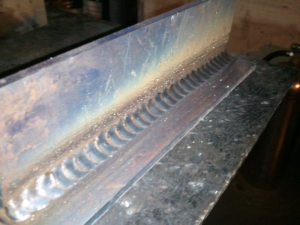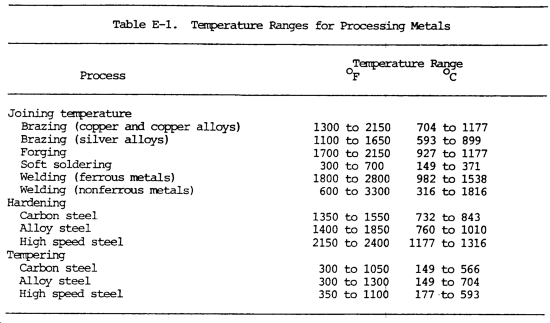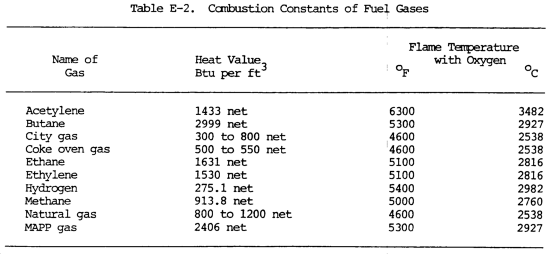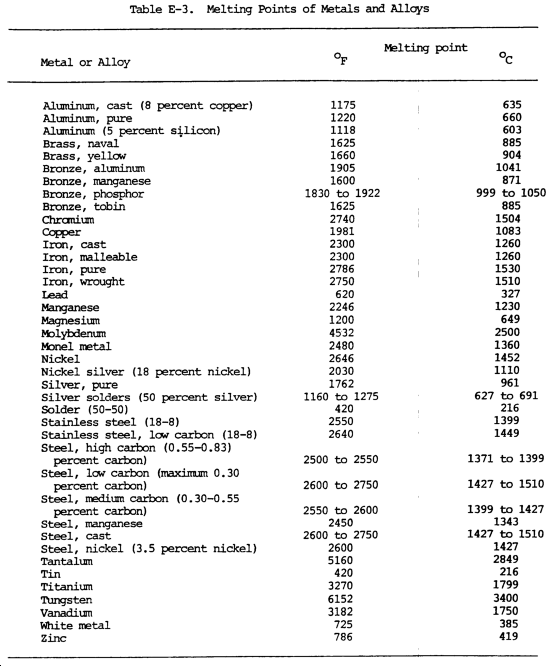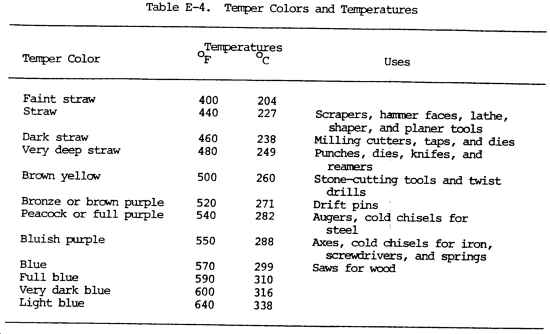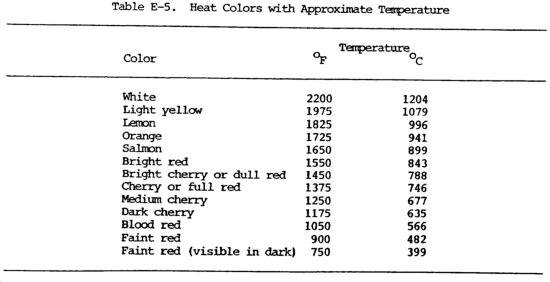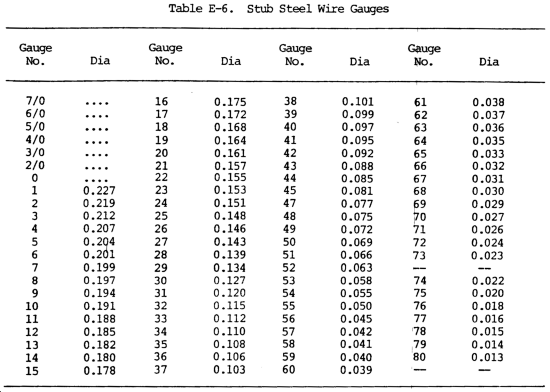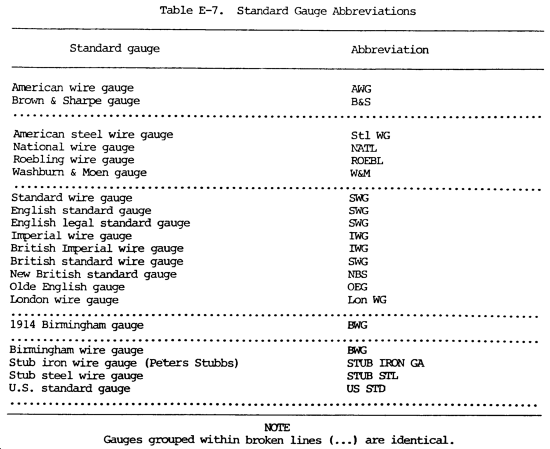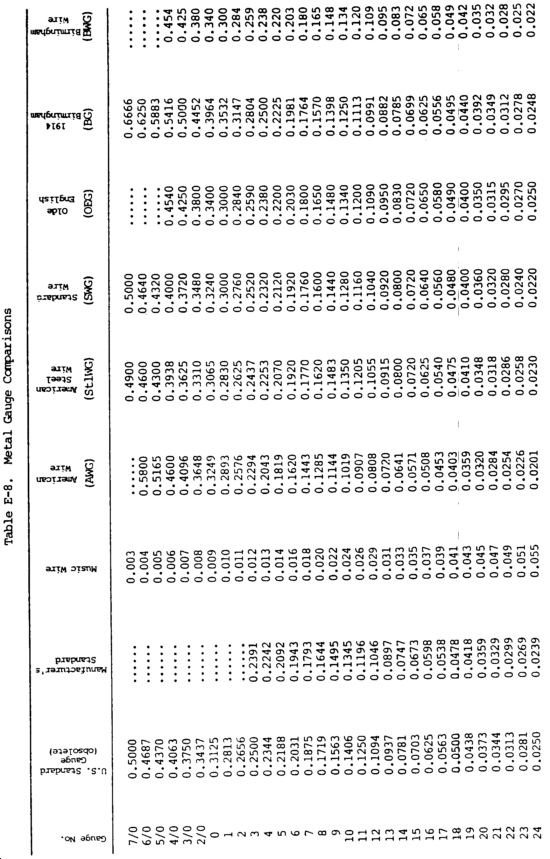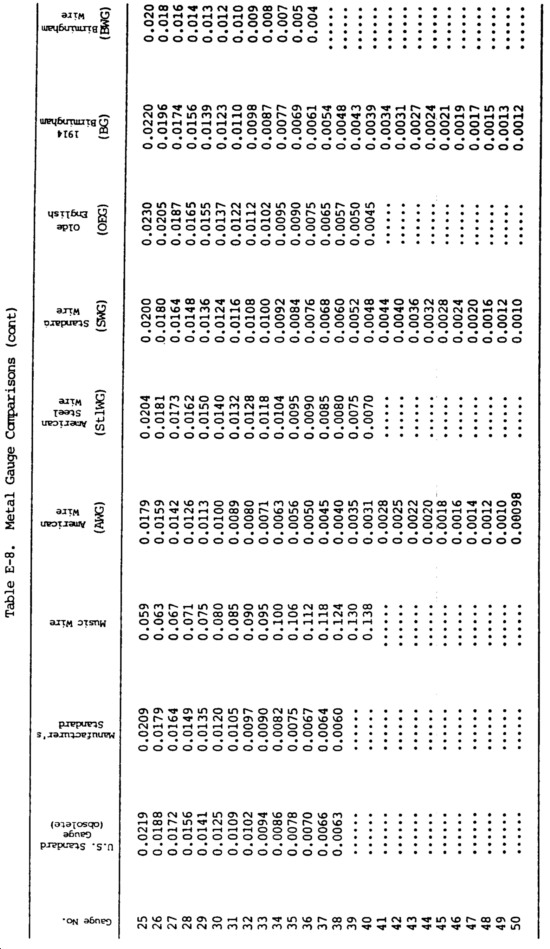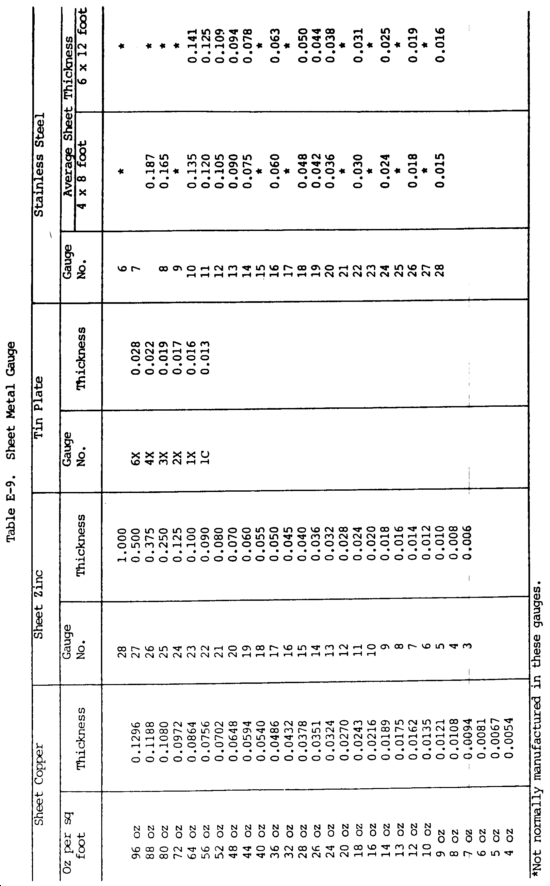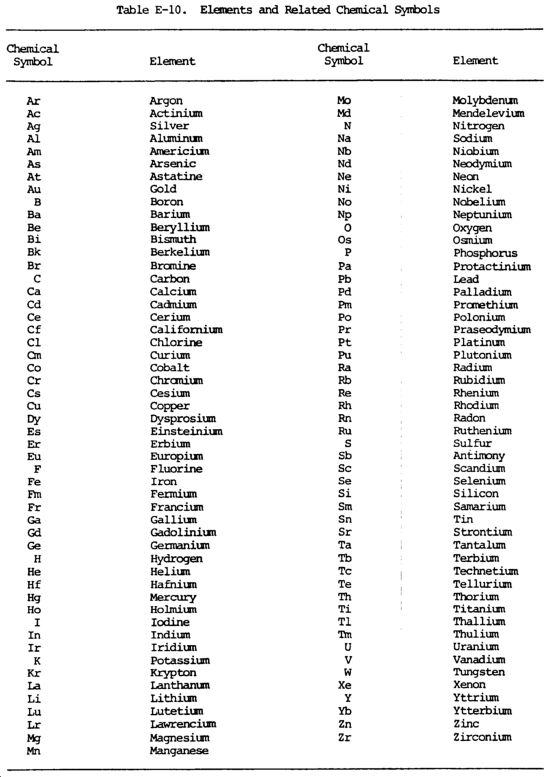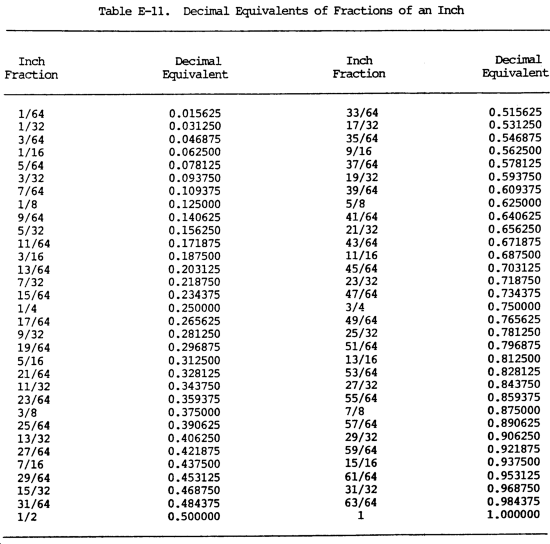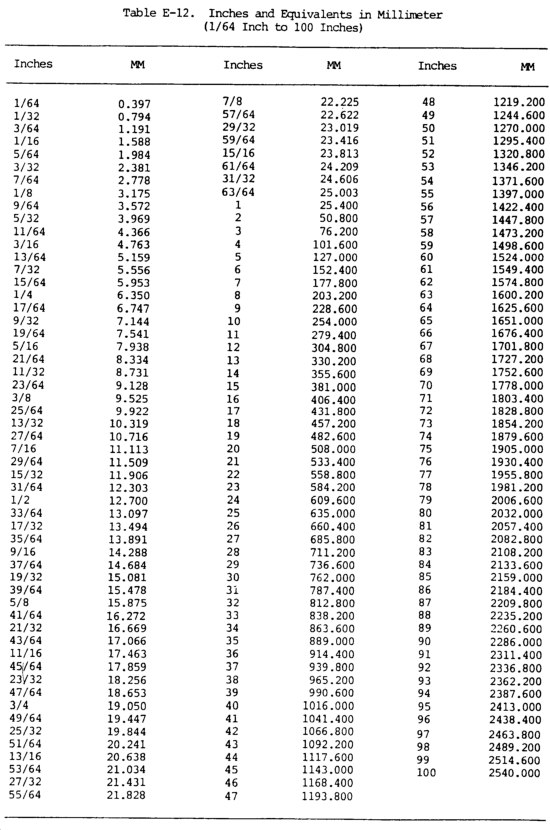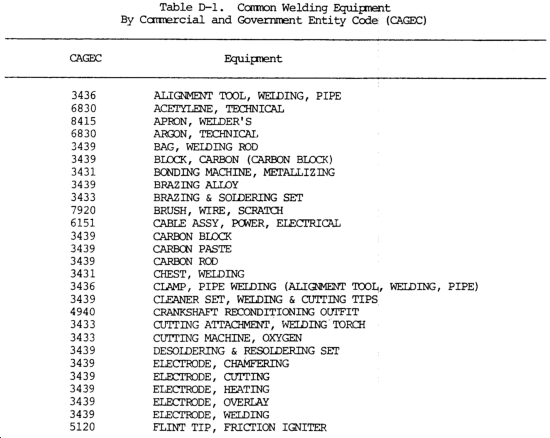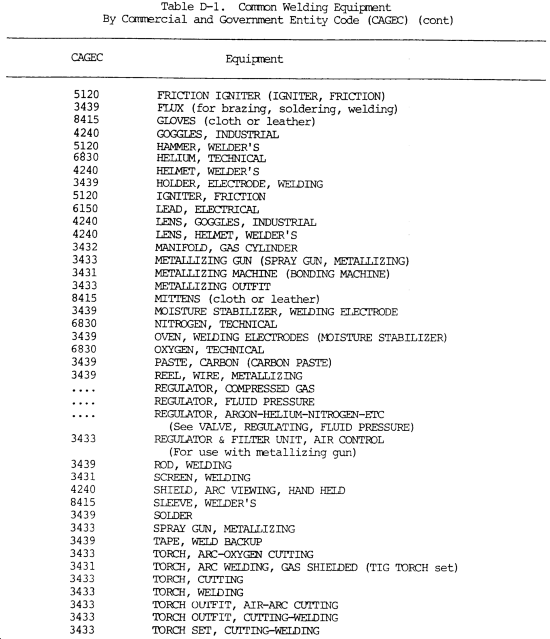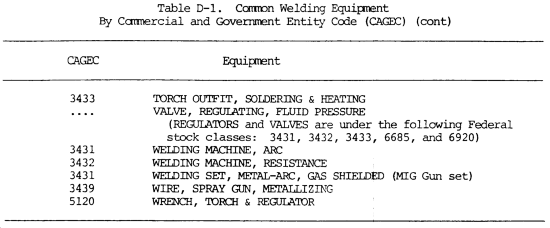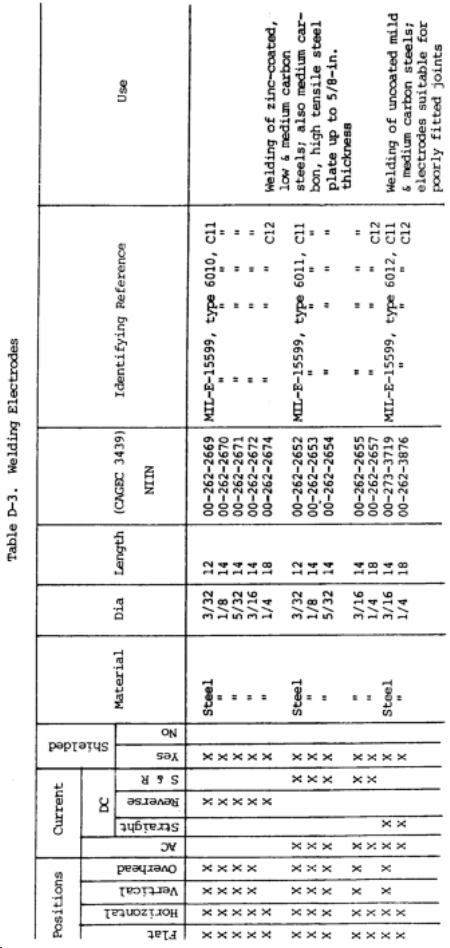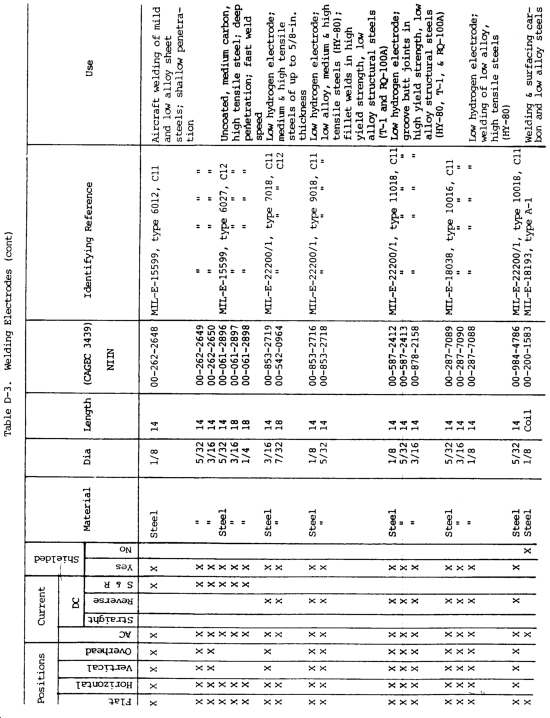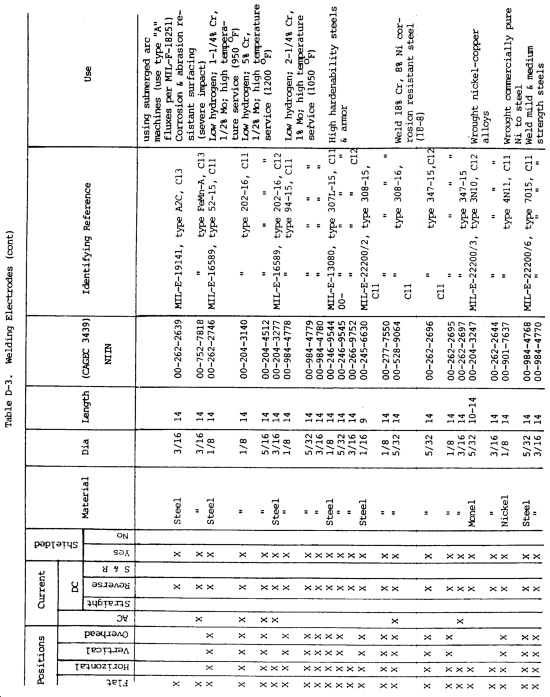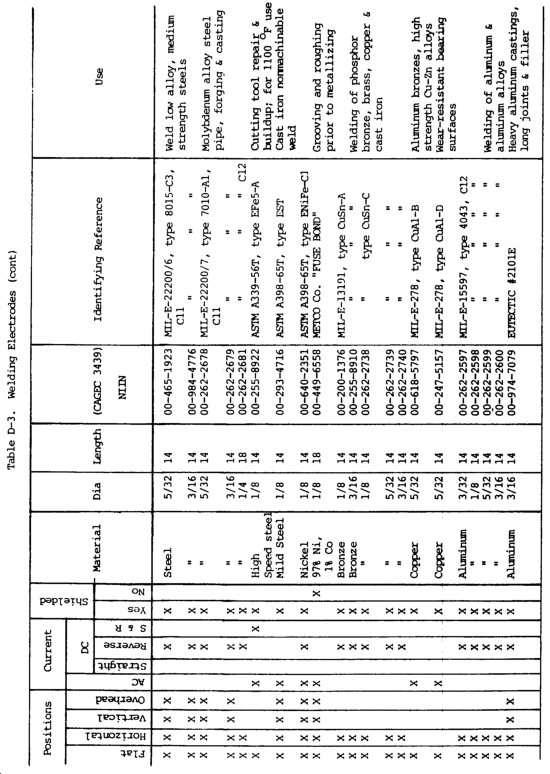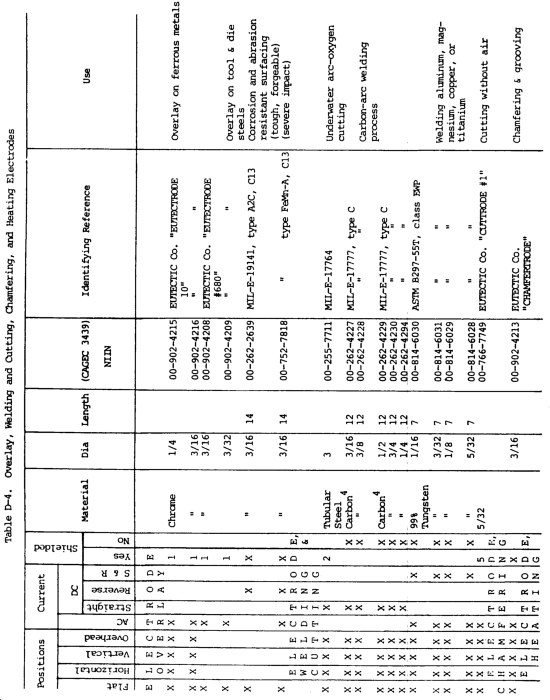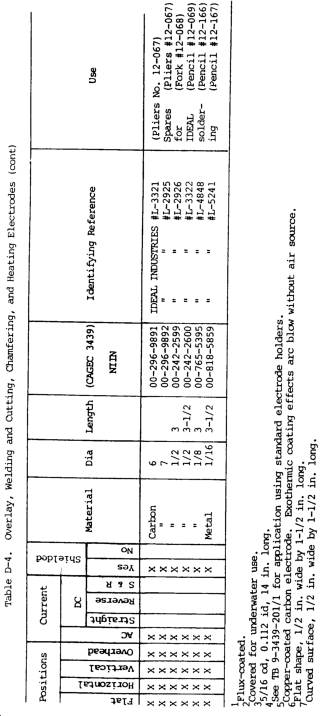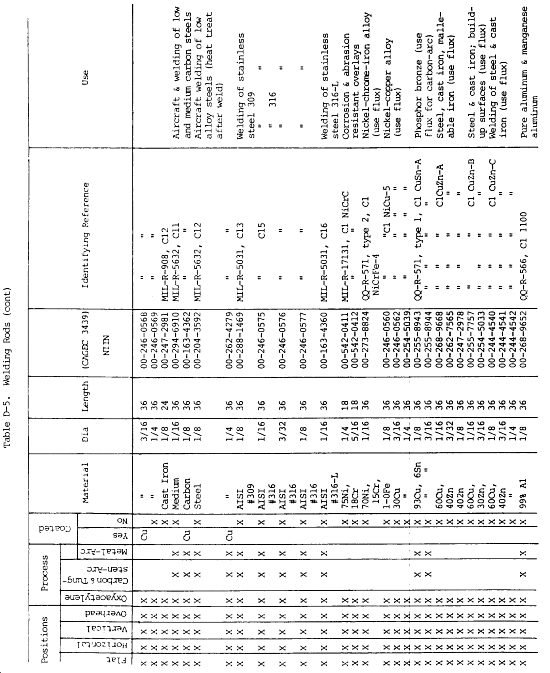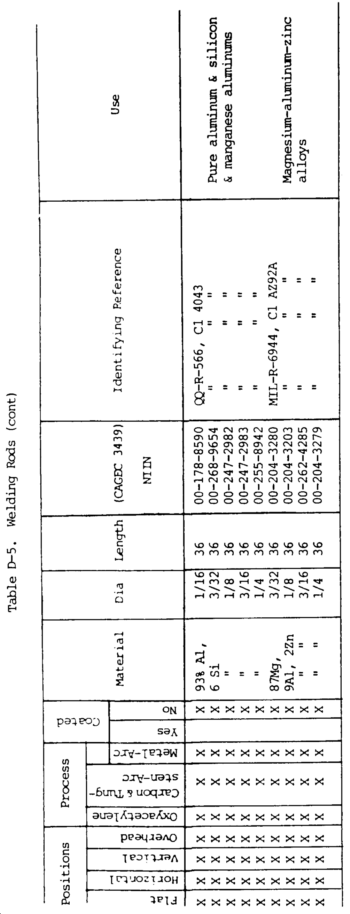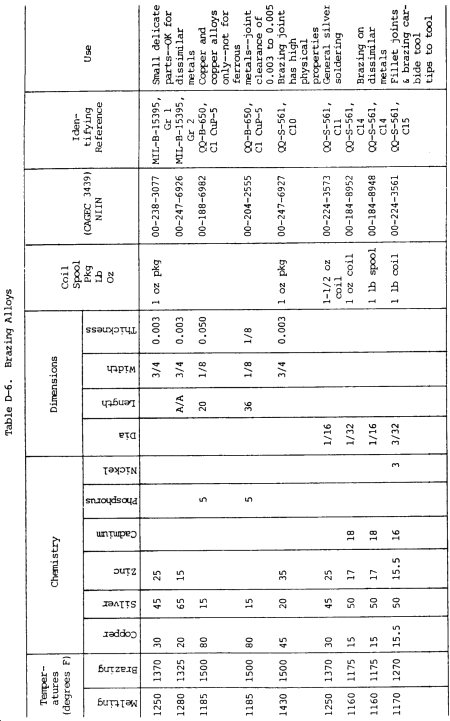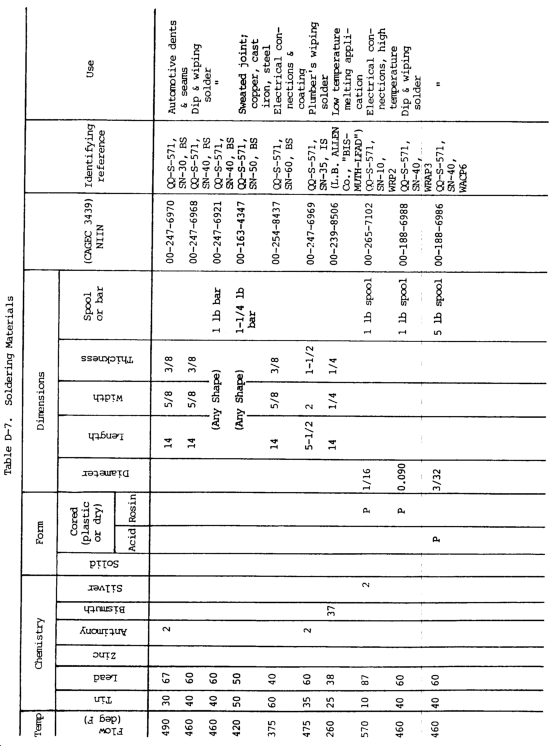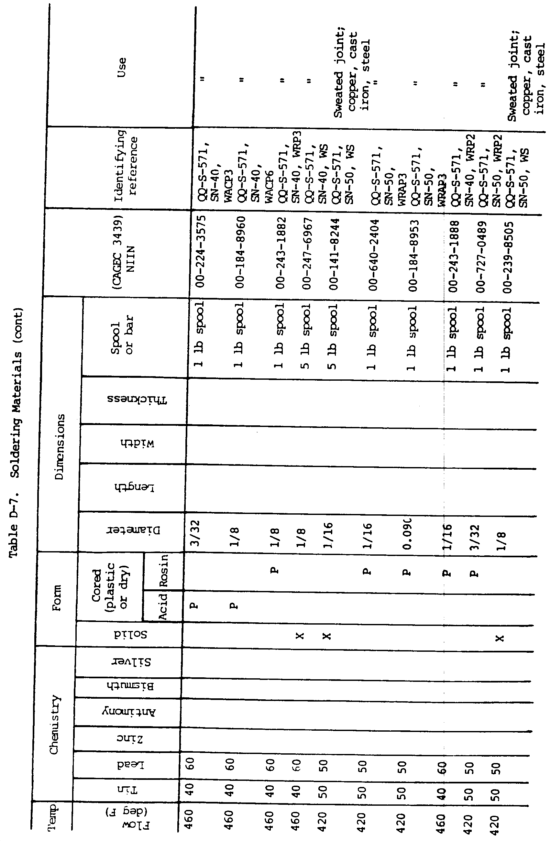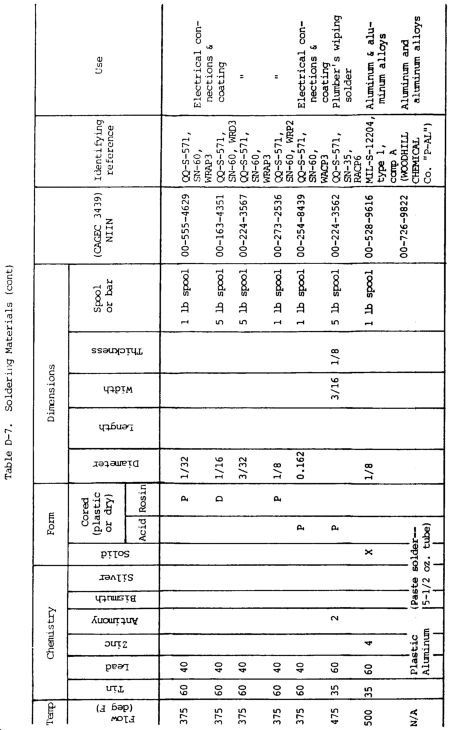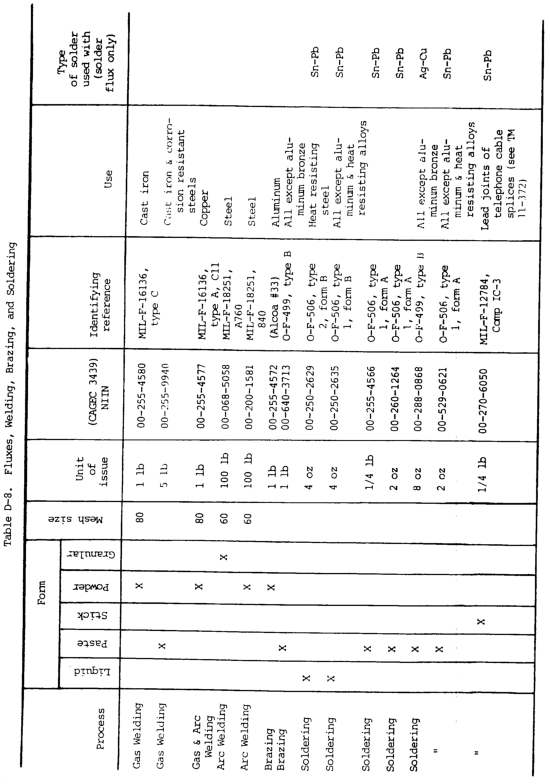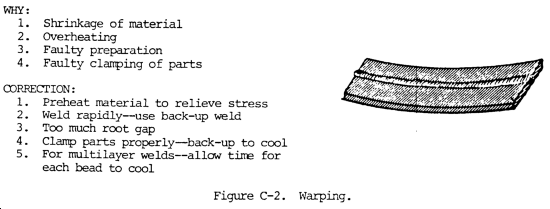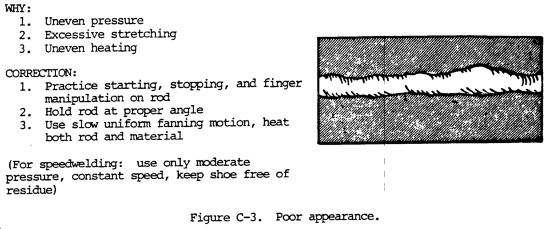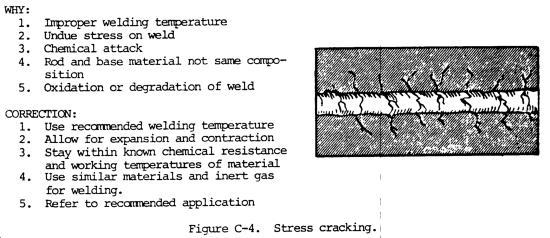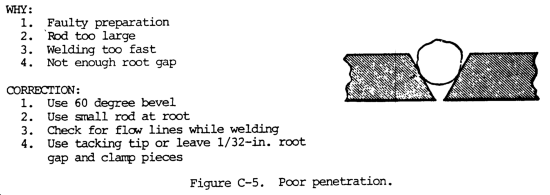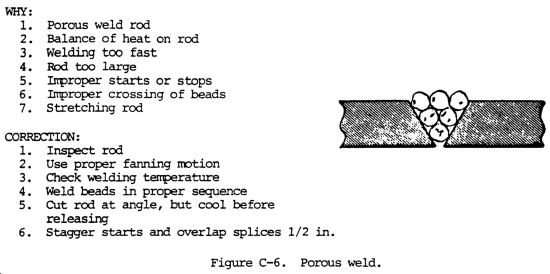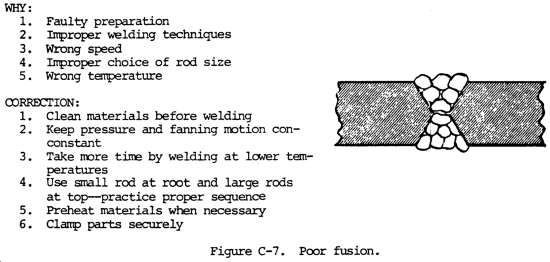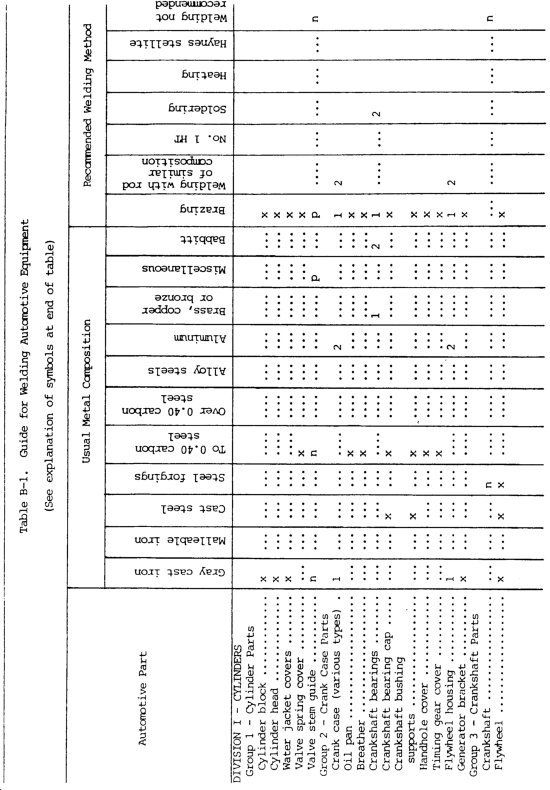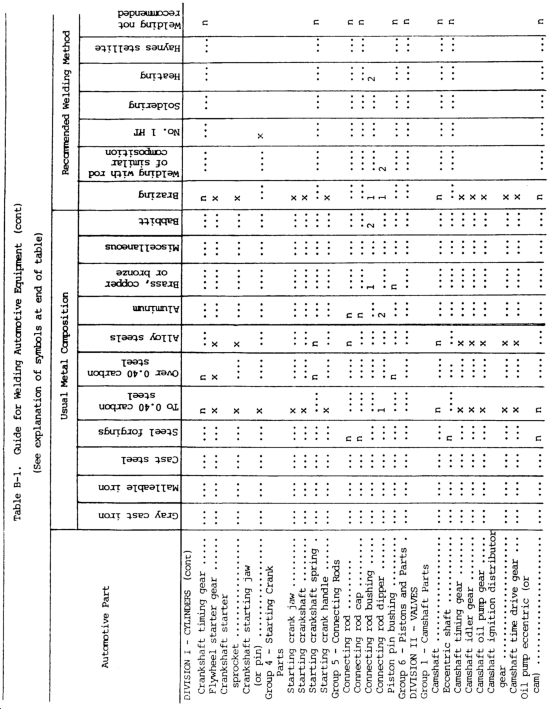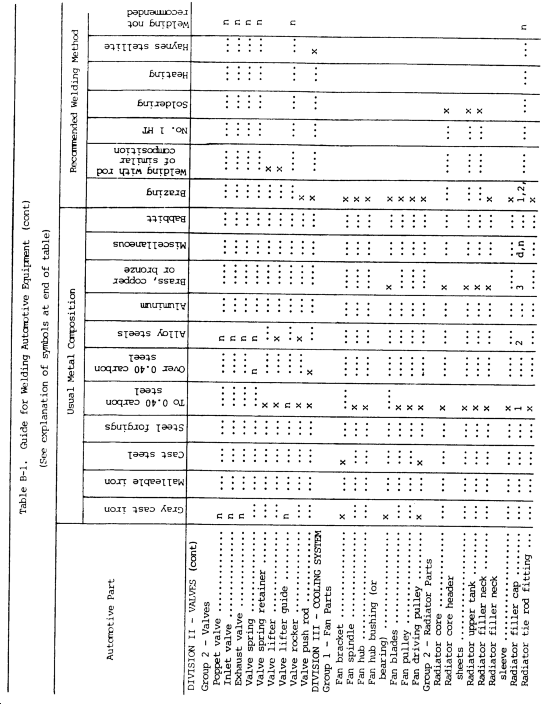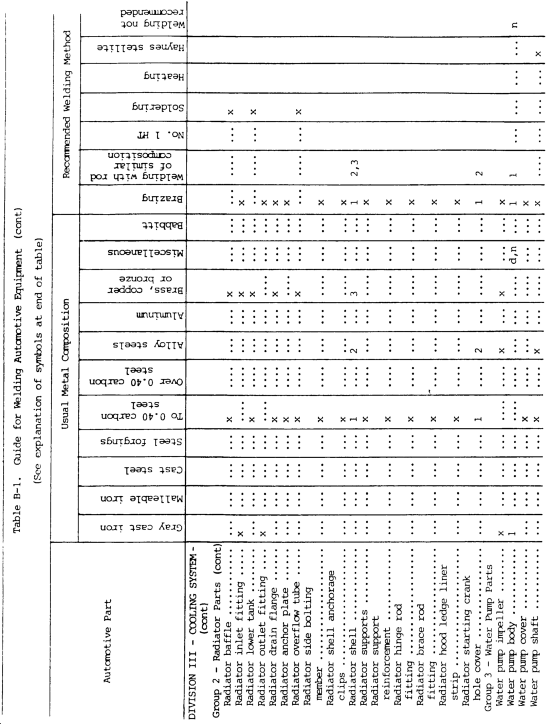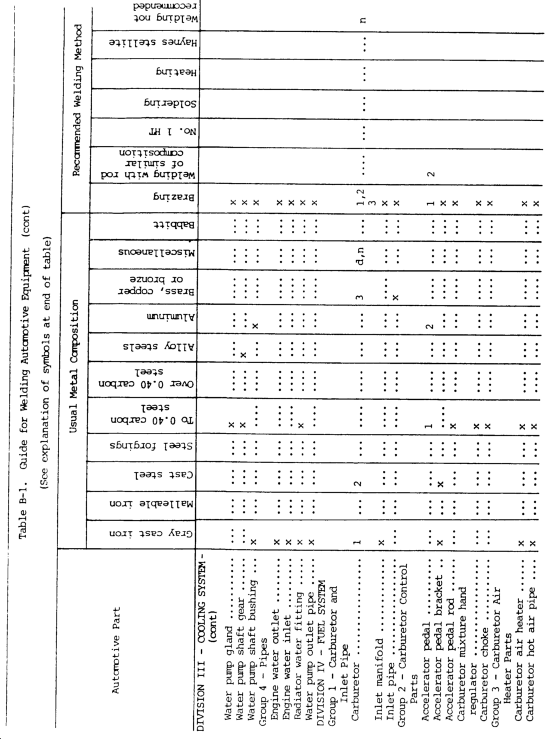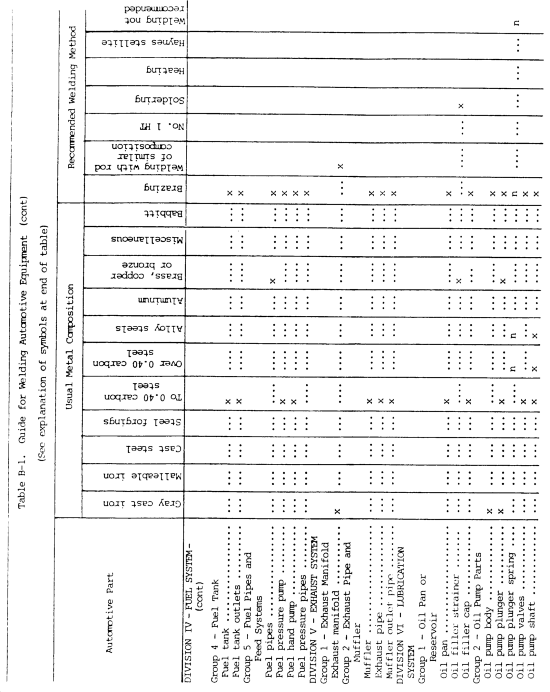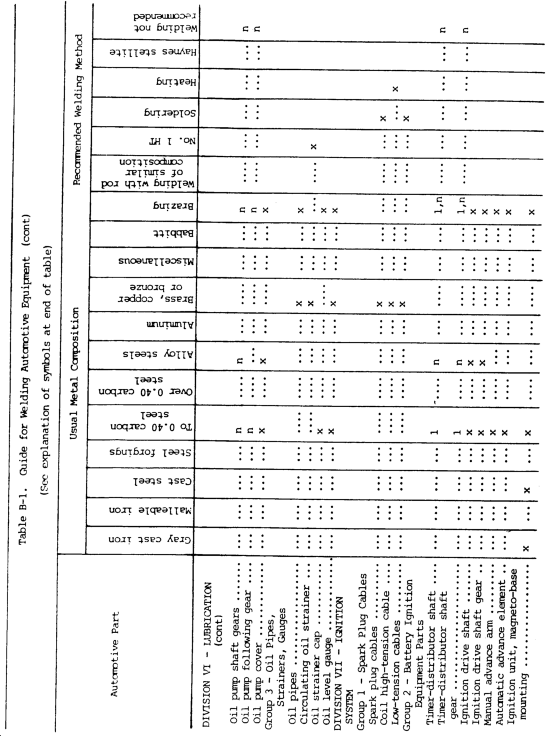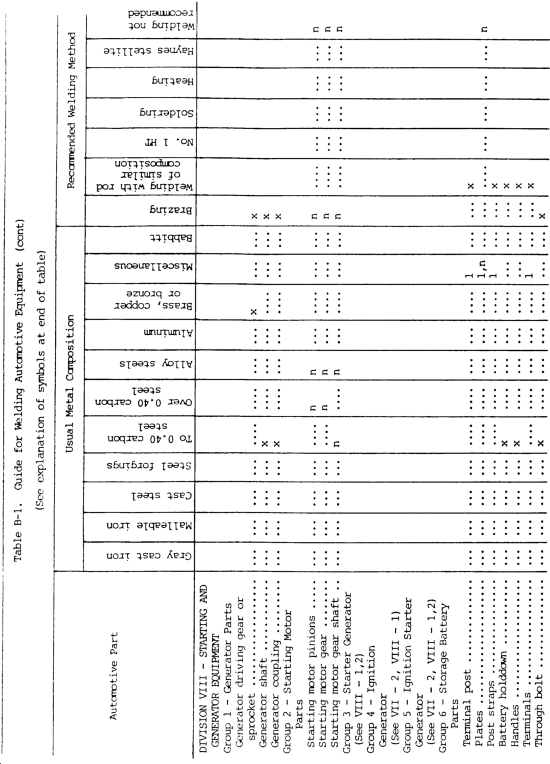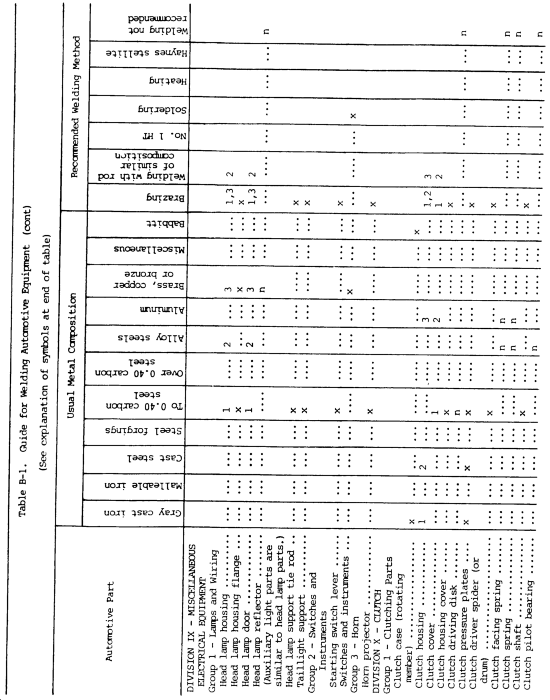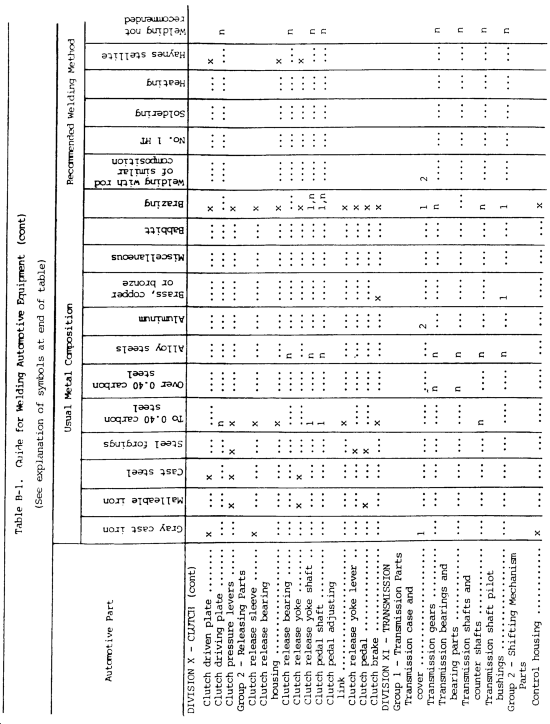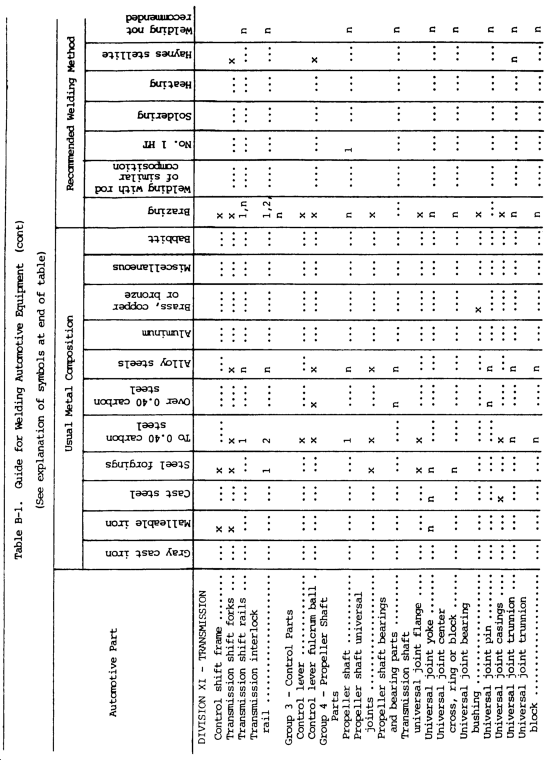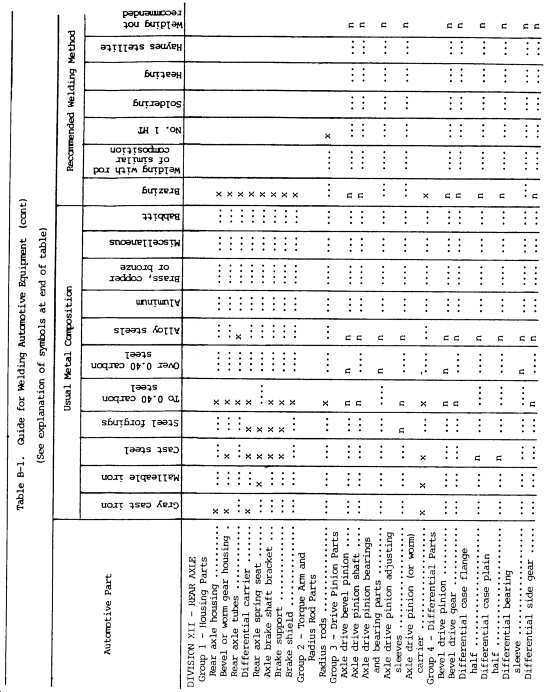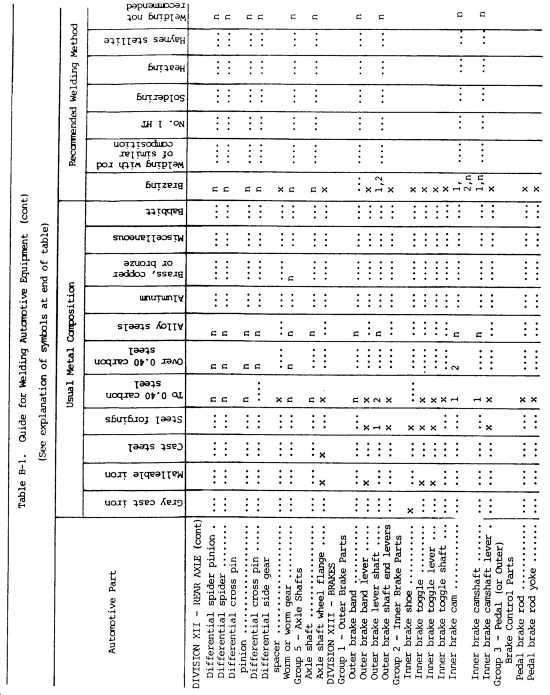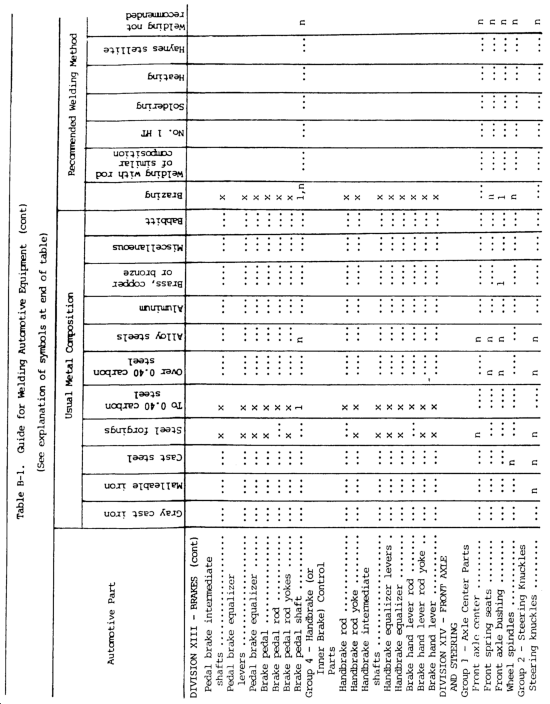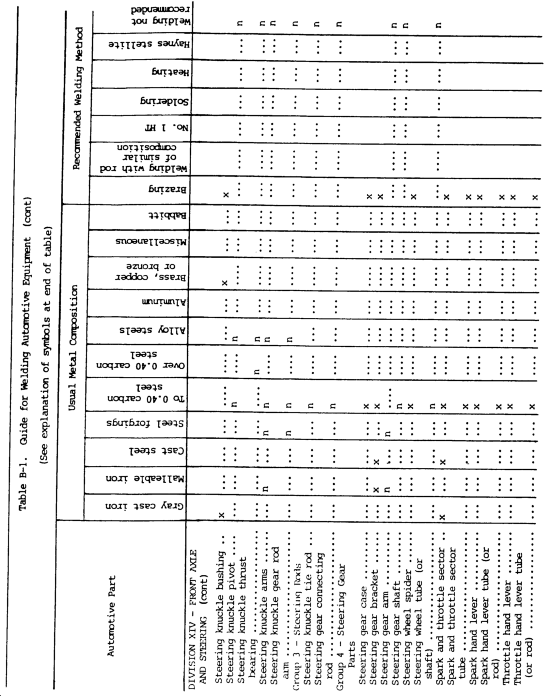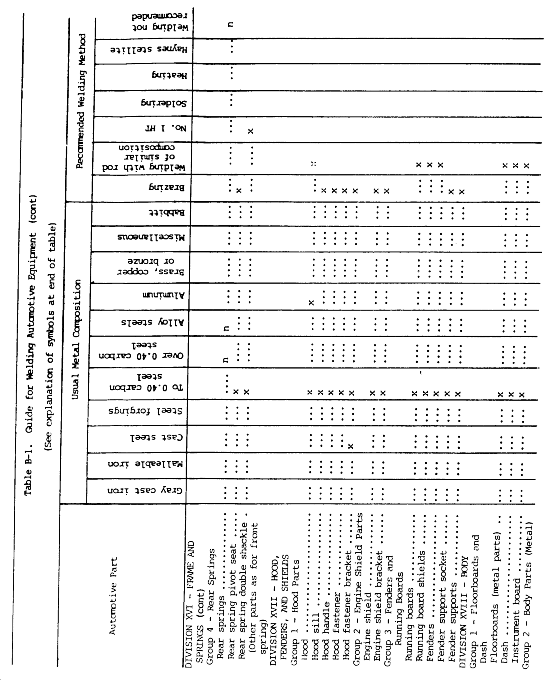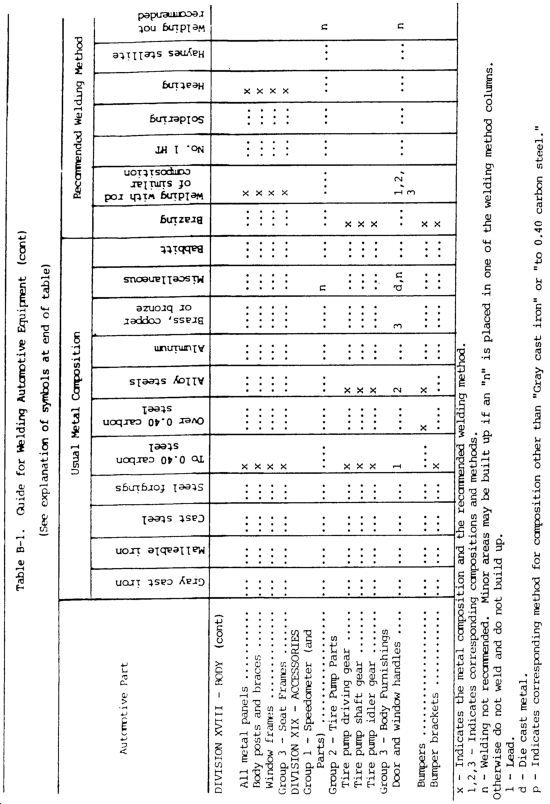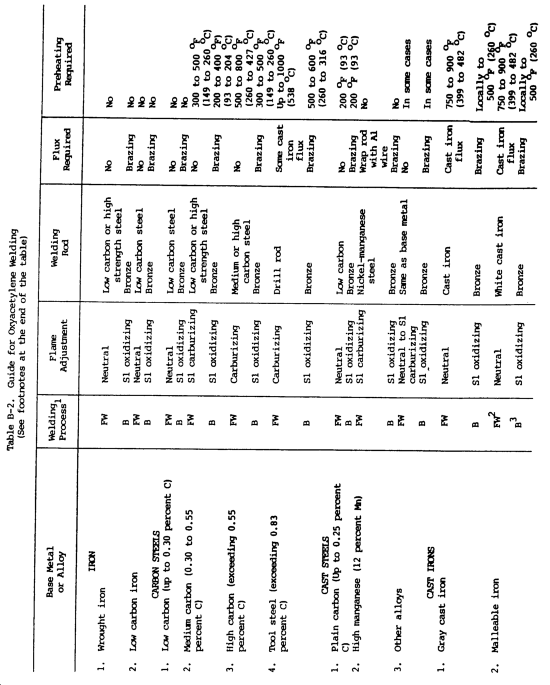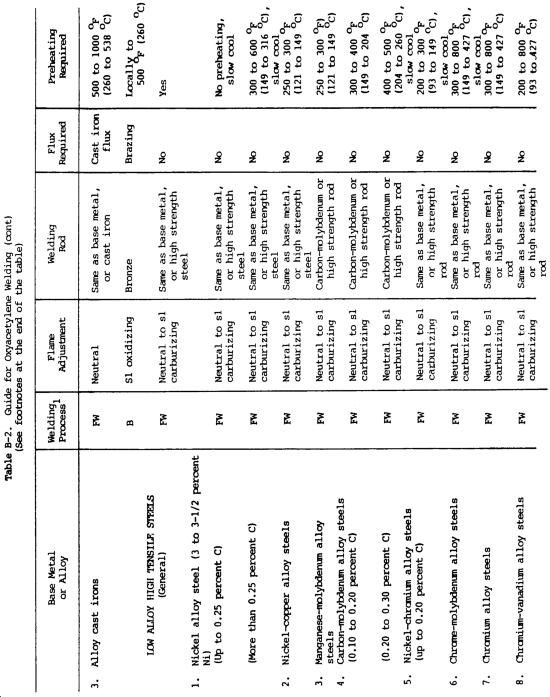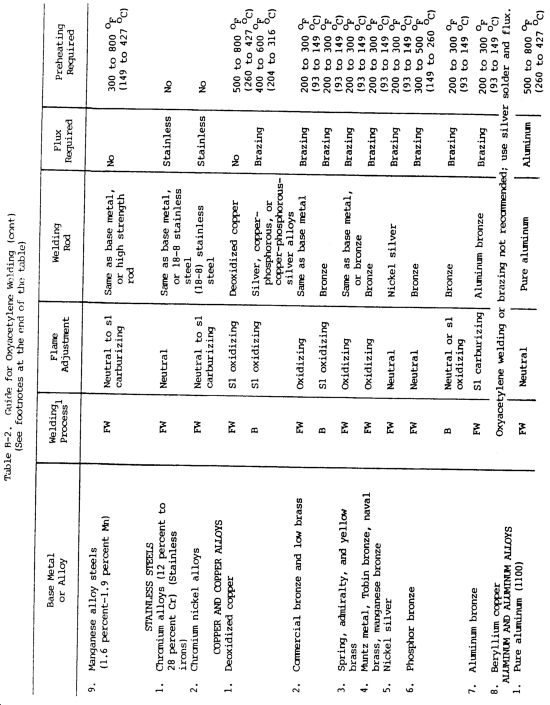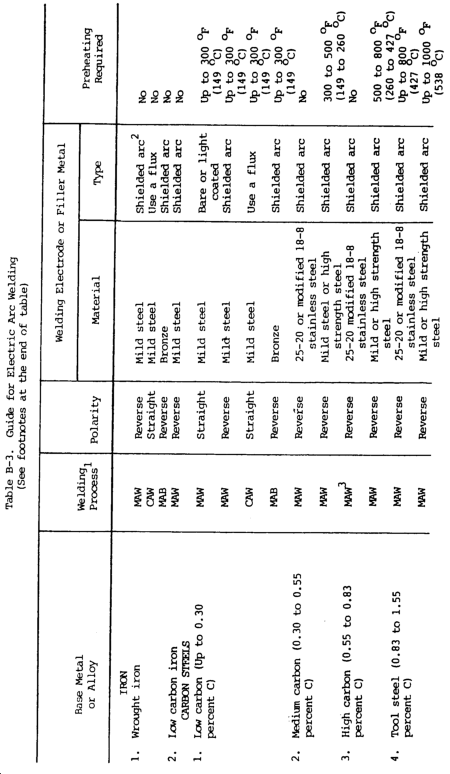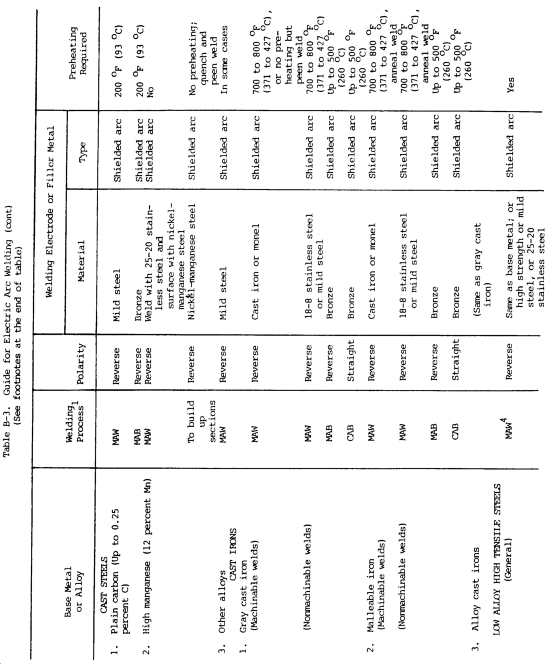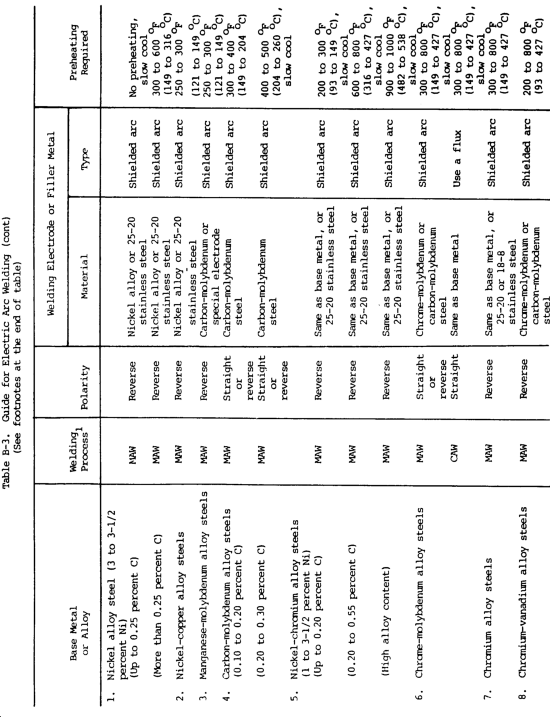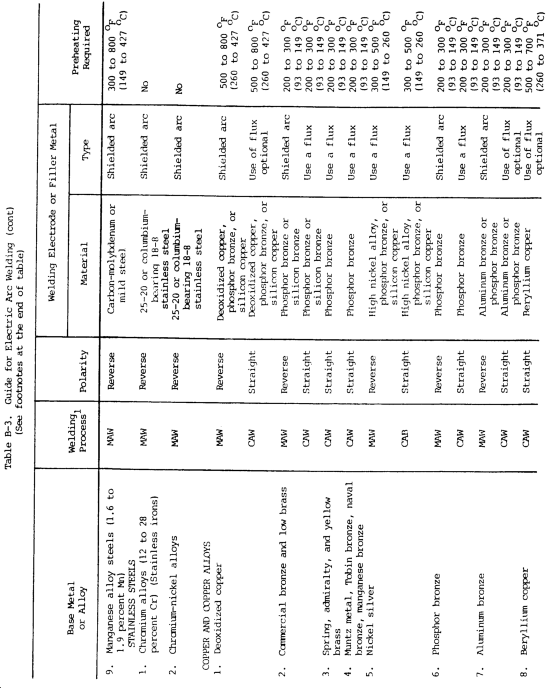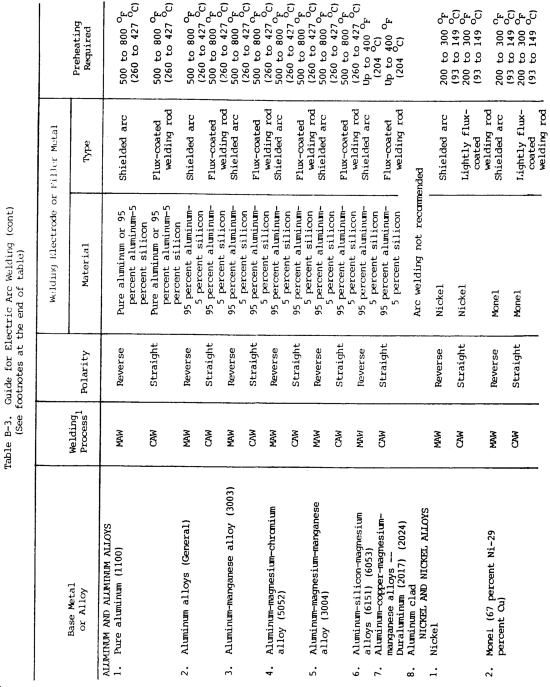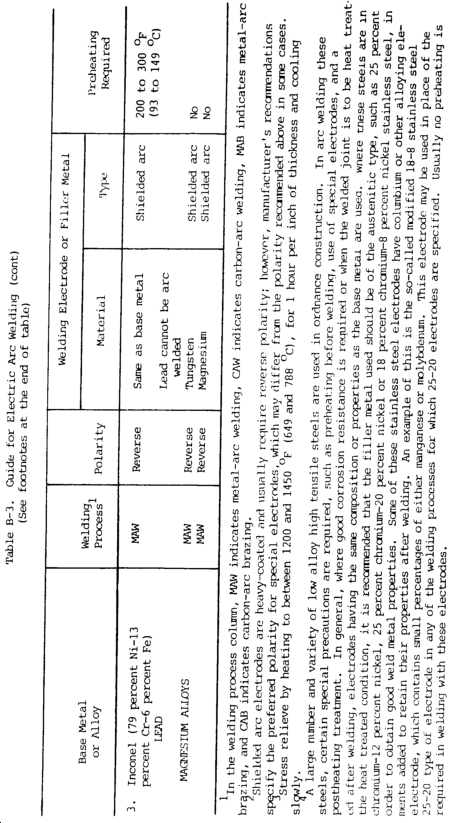Aluminium Welding
Aluminium is a lightweight, soft, low strength metal which can easily be cast, forged, machined, formed and welded.
Unless alloyed with specific elements, it is suitable only in low temperature applications.
Aluminium is light gray to silver in color, very bright when polished, and dull when oxidized.
A fracture in Aluminium sections shows a smooth, bright structure.
Aluminium gives off no sparks in a spark test, and does not show red prior to melting.
A heavy film of white oxide forms instantly on the molten surface.
Its combination of light weight and high strength make Aluminium the second most popular metal that is welded.
Aluminium Welding
Aluminium and Aluminium alloys can be satisfactorily welded by metal-arc, carbon-arc, and other arc welding processes.
The principal advantage of using arc welding processes is that a highly concentrated heating zone is obtained with the arc.
For this reason, excessive expansion and distortion of the metal are prevented.
Aluminium Welding
b. Alloys. Many alloys of Aluminium have been developed. It is important to know which alloy is to be welded. A system of four-digit numbers has been developed by the Aluminium Association, Inc., to designate the various wrought Aluminium alloy types. This system of alloy groups, shown by table 7-20, is as follows:
(1) 1XXX series. These are Aluminiums of 99 percent or higher purity which are used primarily in the electrical and chemical industries.
(2) 2XXX series. Copper is the principal alloy in this group, which provides extremely high strength when properly heat treated. These alloys do not produce as good corrosion resistance and are often clad with pure Aluminium or special-alloy Aluminium. These alloys are used in the aircraft industry.
(3) 3XXX series. Manganese is the major alloying element in this group, which is non-heat-treatable. Manganese content is limited to about 1.5 percent. These alloys have moderate strength and are easily worked.
(4) 4XXX series. Silicon is the major alloying element in this group. It can be added in sufficient quantities to substantially reduce the melting point and is used for brazing alloys and welding electrodes. Most of the alloys in this group are non-heat-treatable.
(5) 5XXX series. Magnesium is the major alloying element of this group, which are alloys of medium strength. They possess good welding characteristics and good resistance to corrosion, but the amount of cold work should be limited.
(6) 6XXX series. Alloys in this group contain silicon and magnesium, which make them heat treatable. These alloys possess medium strength and good corrosion resistance.
(7) 7XXX series. Zinc is the major alloying element in this group. Magnesium is also included in most of these alloys. Together, they form a heat-treatable alloy of very high strength, which is used for aircraft frames.
c. Aluminium Welding
Welding Aluminium Alloys. Aluminium possesses a number of properties that make welding it different than the welding of steels. These are: Aluminium oxide surface coating; high thermal conductivity; high thermal expansion coefficient; low melting temperature; and the absence of color change as temperature approaches the melting point. The normal metallurgical factors that apply to other metals apply to Aluminium as well.
(1) Aluminium is an active metal which reacts with oxygen in the air to produce a hard, thin film of Aluminium oxide on the surface. The melting point of Aluminium oxide is approximately 3600ºF (1982ºC) which is almost three times the melting point of pure Aluminium (1220ºF (660ºC)). In addition, this Aluminium oxide film absorbs moisture from the air, particularly as it becomes thicker. Moisture is a source of hydrogen, which causes porosity in Aluminium welds. Hydrogen may also come from oil, paint, and dirt in the weld area. It also comes from the oxide and foreign materials on the electrode or filler wire, as well as from the base metal. Hydrogen will enter the weld pool and is soluble in molten Aluminium. As the Aluminium solidifies, it will retain much less hydrogen. The hydrogen is rejected during solidification. With a rapid cooling rate, free hydrogen is retained within the weld and will cause porosity. Porosity will decrease weld strength and ductility, depending on the amount.
Aluminium Welding
Aluminium and Aluminium alloys should not be cleaned with caustic soda or cleaners with a pH above 10, as they may react chemically.
(a) The Aluminium oxide film must be removed prior to welding. If it is not completely removed, small particles of unmelted oxide will be trapped in the weld pool and will cause a reduction in ductility, lack of fusion, and possibly weld cracking.
Aluminium Welding
(b) The Aluminium oxide can be removed by mechanical, chemical, or electrical means. Mechanical removal involves scraping with a sharp tool, sandpaper, wire brush (stainless steel), filing, or any other mechanical method. Chemical removal can be done in two ways. One is by use of cleaning solutions, either the etching types or the nonetching types. The nonetching types should be used only when starting with relatively clean parts, and are used in conjunction with other solvent cleaners. For better cleaning, the etching type solutions are recommended, but must be used with care. When dipping is employed, hot and cold rinsing is highly recommended. The etching type solutions are alkaline solutions. The time in the solution must be controlled so that too much etching does not occur.
Aluminium Welding
(c) Chemical cleaning includes the use of welding fluxes. Fluxes are used for gas welding, brazing, and soldering. The coating on covered Aluminium electrodes also maintains fluxes for cleaning the base metal. Whenever etch cleaning or flux cleaning is used, the flux and alkaline etching materials must be completely removed from the weld area to avoid future corrosion.
Aluminium Welding
(d) The electrical oxide removal system uses cathodic bombardment. Cathodic bombardment occurs during the half cycle of alternating current gas tungsten arc welding when the electrode is positive (reverse polarity). This is an electrical phenomenon that actually blasts away the oxide coating to produce a clean surface. This is one of the reasons why AC gas tungsten arc welding is so popular for welding Aluminium.
Aluminium Welding
(e) Since Aluminium is so active chemically, the oxide film will immediately start to reform. The time of buildup is not extremely fast, but welds should be made after Aluminium is cleaned within at least 8 hours for quality welding. If a longer time period occurs, the quality of the weld will decrease.
Aluminium Welding
(2) Aluminium has a high thermal conductivity and low melting temperature. It conducts heat three to five times as fast as steel, depending on the specific alloy. More heat must be put into the Aluminium, even though the melting temperature of Aluminium is less than half that of steel. Because of the high thermal conductivity, preheat is often used for welding thicker sections. If the temperature is too high or the time period is too long, weld joint strength in both heat-treated and work-hardened alloys may be diminished. The preheat for Aluminium should not exceed 400ºF (204ºC), and the parts should not be held at that temperature longer than necessary. Because of the high heat conductivity, procedures should utilize higher speed welding processes using high heat input. Both the gas tungsten arc and the gas metal arc processes supply this requirement. The high heat conductivity of Aluminium can be helpful, since the weld will solidify very quickly if heat is conducted away from the weld extremely fast. Along with surface tension, this helps hold the weld metal in position and makes all-position welding with gas tungsten arc and gas metal arc welding practical.
(3) The thermal expansion of Aluminium is twice that of steel. In addition, Aluminium welds decrease about 6 percent in volume when solidifying from the molten state. This change in dimension may cause distortion and cracking.
(4) The final reason Aluminium is different from steels when welding is that it does not exhibit color as it approaches its melting temperature until it is raised above the melting point, at which time it will glow a dull red. When soldering or brazing Aluminium with a torch, flux is used. The flux will melt as the temperature of the base metal approaches the temperature required. The flux dries out first, and melts as the base metal reaches the correct working temperature. When torch welding with oxyacetylene or oxyhydrogen, the surface of the base metal will melt first and assume a characteristic wet and shiny appearance. (This aids in knowing when welding temperatures are reached.) When welding with gas tungsten arc or gas metal arc, color is not as important, because the weld is completed before the adjoining area melts.
d. Aluminium Welding Metal-Arc Welding of Aluminium.
(1) Plate welding. Because of the difficulty of controlling the arc, butt and fillet welds are difficult to produce in plates less than 1/8 in. (3.2 mm) thick. When welding plate heavier than 1/8 in. (3.2 mm), a joint prepared with a 20 degree bevel will have strength equal to a weld made by the oxyacetylene process. This weld may be porous and unsuitable for liquid-or gas-tight joints. Metal-arc welding is, however, particularly suitable for heavy material and is used on plates up to 2-1/2 in. (63.5 mm) thick.
(2) Current and polarity settings. The current and polarity settings will vary with each manufacturer’s type of electrodes. The polarity to be used should be determined by trial on the joints to be made.
(3) Plate edge preparation. In general, the design of welded joints for Aluminium is quite consistent with that for steel joints. However, because of the higher fluidity of Aluminium under the welding arc, some important general principles should be kept in mind. With the lighter gauges of Aluminium sheet, less groove spacing is advantageous when weld dilution is not a factor. The controlling factor is joint preparation. A specially designed V groove that is applicable to Aluminium is shown in A, figure 7-11. This type of joint is excellent where welding can be done from one side only and where a smooth, penetrating bead is desired. The effectiveness of this particular design depends upon surface tension, and should be applied on all material over 1/8 in. (3.2 mm) thick. The bottom of the special V groove must be wide enough to contain the root pass completely. This requires adding a relatively large amount of filler alloy to fill the groove. Excellent control of the penetration and sound root pass welds are obtained. This edge preparation can be employed for welding in all positions. It eliminates difficulties due to burn-through or over-penetration in the overheat and horizontal welding positions. It is applicable to all weldable base alloys and all filler alloys.
e. Aluminium Welding Gas Metal-Arc (MIG) Welding (GMAW).
(1) General. This fast, adaptable process is used with direct current re-verse polarity and an inert gas to weld heavier thicknesses of Aluminium alloys, in any position, from 1/016 in. (1.6 mm) to several inches thick. TM 5-3431-211-15 describes the operation of a typical MIG welding set.
(2) Shielding gas. Precautions should be taken to ensure the gas shield is extremely efficient. Welding grade argon, helium, or a mixture of these gases is used for Aluminium welding. Argon produces a smother and more stable arc than helium. At a specific current and arc length, helium provides deeper penetration and a hotter arc than argon. Arc voltage is higher with helium, and a given change in arc length results in a greater change in arc voltage. The bead profile and penetration pattern of Aluminium welds made with argon and helium differ. With argon, the bead profile is narrower and more convex than helium. The penetration pattern shows a deep central section. Helium results in a flatter, wider bead, and has a broader under-bead penetration pattern. A mixture of approximately 75 percent helium and 25 percent argon provides the advantages of both shielding gases with none of the undesirable characteristics of either. Penetration pattern and bead contour show the characteristics of both gases. Arc stability is comparable to argon. The angle of the gun or torch is more critical when welding Aluminium with inert shielding gas. A 30º leading travel angle is recommended. The electrode wire tip should be oversize for Aluminium. Table 7-21 provides welding procedure schedules for gas metal-arc welding of Aluminium.
(3) Aluminium Welding Welding technique. The electrode wire must be clean. The arc is struck with the electrode wire protruding about 1/2 in. (12.7 mm) from the cup. A frequently used technique is to strike the arc approximately 1.0 in. (25.4 mm) ahead of the beginning of the weld and then quickly bring the arc to the weld starting point, reverse the direction of travel, and proceed with normal welding. Alternatively, the arc may be struck outside the weld groove on a starting tab. When finishing or terminating the weld, a similar practice may be followed by reversing the direction of welding, and simultaneously increasing the speed of welding to taper the width of the molten pool prior to breaking the arc. This helps to avert craters and crater cracking. Runoff tabs are commonly used. Having established the arc, the welder moves the electrode along the joint while maintaining a 70 to 85 degree forehand angle relative to the work. A string bead technique is normally preferred. Care should be taken that the forehand angle is not changed or increased as the end of the weld is approached. Arc travel speed controls the bead size. When welding Aluminium with this process, it is must important that high travel speeds be maintained. When welding uniform thicknesses, the electrode to work angle should be equal on both sides of the weld. When welding in the horizontal position, best results are obtained by pointing the gun slightly upward. When welding thick plates to thin plates, it is helpful to direct the arc toward the heavier section. A slight backhand angle is sometimes helpful when welding thin sections to thick sections. The root pass of a joint usually requires a short arc to provide the desired penetration. Slightly longer arcs and higher arc voltages may be used on subsequent passes.
The wire feeding equipment for Aluminium welding must be in good adjustment for efficient wire feeding. Use nylon type liners in cable assemblies. Proper drive rolls must be selected for the Aluminium wire and for the size of the electrode wire. It is more difficult to push extremely small diameter Aluminium wires through long gun cable assemblies than steel wires. For this reason, the spool gun or the newly developed guns which contain a linear feed motor are used for the small diameter electrode wires. Water-cooled guns are required except for low-current welding. Both the constant current (CC) power source with matching voltage sensing wire feeder and the constant voltage (CV) power source with constant speed wire feeder are used for welding Aluminium. In addition, the constant speed wire feeder is sometimes used with the constant current power source. In general, the CV system is preferred when welding on thin material and using all diameter electrode wire. It provides better arc starting and regulation. The CC system is preferred when welding thick material using larger electrode wires. The weld quality seems better with this system. The constant current power source with a moderate drop of 15 to 20 volts per 100 amperes and a constant speed wire feeder provide the most stable power input to the weld and the highest weld quality.
(4) Aluminium Welding Joint design. Edges may be prepared for welding by sawing, machining, rotary planing, routing or arc cutting. Acceptable joint designs are shown in figure 7-12.
f. Aluminium Welding Gas Tungsten-Arc (TIG) Welding (GTAW).
(1) The gas tungsten arc welding process is used for welding the thinner sections of Aluminium and Aluminium alloys. There are several precautions that should be mentioned with respect to using this process.
(a) Alternating current is recommended for general-purpose work since it provides the half-cycle of cleaning action. Table 7-22 provides welding procedure schedules for using the process on different thicknesses to produce different welds. AC welding, usually with high frequency, is widely used with manual and automatic applications. Procedures should be followed closely and special attention given to the type of tungsten electrode, size of welding nozzle, gas type, and gas flow rates. When manual welding, the arc length should be kept short and equal to the diameter of the electrode. The tungsten electrode should not protrude too far beyond the end of the nozzle. The tungsten electrode should be kept clean. If it does accidentally touch the molten metal, it must be redressed.
(b) Aluminium WeldingWelding power sources designed for the gas tungsten arc welding process should be used. The newer equipment provides for programming, pre-and post-flow of shielding gas, and pulsing.
(c) Aluminium Welding For automatic or machine welding, direct current electrode negative (straight polarity) can be used. Cleaning must be extremely efficient, since there is no cathodic bombardment to assist. When dc electrode negative is used, extremely deep penetration and high speeds can be obtained. Table 7-23 lists welding procedure schedules for dc electrode negative welding.
(d) The Aluminium Welding shielding gases are argon, helium, or a mixture of the two. Argon is used at a lower flow rate. Helium increases penetration, but a higher flow rate is required. When filler wire is used, it must be clean. Oxide not removed from the filler wire may include moisture that will produce polarity in the weld deposit.
(2) Alternating current.
(a) Characteristics of process. The Aluminium Welding of Aluminium by the gas tungsten-arc welding process using alternating current produces an oxide cleaning action. Argon shielding gas is used. Better results are obtained when welding Aluminium with alternating current by using equipment designed to produce a balanced wave or equal current in both directions. Unbalance will result in loss of power and a reduction in the cleaning action of the arc. Characteristics of a stable arc are the absence of snapping or cracking, smooth arc starting, and attraction of added filler metal to the weld puddle rather than a tendency to repulsion. A stable arc results in fewer tungsten inclusions.
(b) Aluminium Welding technique. For manual welding of Aluminium with ac, the electrode holder is held in one hand and filler rod, if used, in the other. An initial arc is struck on a starting block to heat the electrode. The arc is then broken and reignited in the joint. This technique reduces the tendency for tungsten inclusions at the start of the weld. The arc is held at the starting point until the metal liquefies and a weld pool is established. The establishment and maintenance of a suitable weld pool is important, and welding must not proceed ahead of the puddle. If filler metal is required, it may be added to the front or leading edge of the pool but to one side of the center line. Both hands are moved in unison with a slight backward and forward motion along the joint. The tungsten electrode should not touch the filler rod. The hot end of the filler rod should not be withdrawn from the argon shield. A short arc length must be maintained to obtain sufficient penetration and avoid undercutting, excessive width of the weld bead, and consequent loss of penetration control and weld contour. One rule is to use an arc length approximately equal to the diameter of the tungsten electrode. When the arc is broken, shrinkage cracks may occur in the weld crater, resulting in a defective weld. This defect can be prevented by gradually lengthening the arc while adding filler metal to the crater. Then, quickly break and restrike the arc several times while adding additional filler metal to the crater, or use a foot control to reduce the current at the end of the weld. Tacking before welding is helpful in controlling distortion. Tack welds should be of ample size and strength and should be chipped out or tapered at the ends before welding over.
(c) Aluminium Welding Joint design. The joint designs shown in figure 7-11 are applicable to the gas tungsten-arc welding process with minor exceptions. Inexperienced welders who cannot maintain a very short arc may require a wider edge preparation, included angle, or joint spacing. Joints may be fused with this process without the addition of filler metal if the base metal alloy also makes a satisfactory filler alloy. Edge and corner welds are rapidly made without addition of filler metal and have a good appearance, but a very close fit is essential.
(3) Aluminium Welding Direct current straight polarity.
(a) Charcteristics of process. This process, using helium and thoriated tungsten electrodes is advantageous for many automatic welding operations, especially in the welding of heavy sections. Since there is less tendency to heat the electrode, smaller electrodes can be used for a given welding current. This will contribute to keeping the weld bead narrow. The use of direct current straight polarity (dcsp) provides a greater heat input than can be obtained with ac current. Greater heat is developed in the weld pool, which is consequently deeper and narrower.
(b) Aluminium Welding techniques. A high frequency current should be used to initiate the arc. Touch starting will contaminate the tungsten electrode. It is not necessary to form a puddle as in ac welding, since melting occurs the instant the arc is struck. Care should be taken to strike the arc within the weld area to prevent undesirable marking of the material. Standard techniques such as runoff tabs and foot operated heat controls are used. These are helpful in preventing or filling craters, for adjusting the current as the work heats, and to adjust for a change in section thickness. In dcsp welding, the torch is moved steadily forward. The filler wire is fed evenly into the leading edge of the weld puddle, or laid on the joint and melted as the arc roves forward. In all cases, the crater should be filled to a point above the weld bead to eliminate crater cracks. The fillet size can be controlled by varying filler wire size. DCSP is adaptable to repair work. Preheat is not required even for heavy sections, and the heat affected zone will be smaller with less distortion.
(c) Aluminium Welding Joint designs. The joint designs shown in figure 7-11 are applicable to the automatic gas tungsten-arc dcsp welding process with minor exceptions. For manual dcsp, the concentrated heat of the arc gives excellent root fusion. Root face can be thicker, grooves narrower, and build up can be easily controlled by varying filler wire size and travel speed.
g. Aluminium Welding Square Wave Alternating Current Welding (TIG).
(1) General. Square wave gas tungsten-arc welding with alternating current differs frozen conventional balanced wave gas tungsten-arc welding in the type of wave from used. With a square wave, the time of current flow in either direction is adjustable from 20 to 1. In square wave gas tungsten-arc welding, there are the advantages of surface cleaning produced by positive ionic bombardment during the reversed polarity cycle, along with greater weld depth to width ratio produced by the straight polarity cycle. Sufficient Aluminium surface cleaning action has been obtained with a setting of approximately 10 percent dcrp. Penetration equal to regular dcsp welding can be obtained with 90 percent dcsp current.
(2) Aluminium Welding technique. It is necessary to have either superimposed high frequency or high open circuit voltage, because the arc is extinguished every half cycle as the current decays toward zero, and must be restarted each tire. Precision shaped thoriated tungsten electrodes should be used with this process. Argon, helium, or a combination of the two should be used as shielding gas, depending on the application to be used.
(3) Aluminium Welding Joint design. Square wave alternating current welding offers substantial savings over conventional alternating current balanced wave gas tungsten arc welding in weld joint preparation. Smaller V grooves, U grooves, and a thicker root face can be used. A greater depth to width weld ratio is conducive to less weldment distortion, along with favorable welding residual stress distribution and less use of filler wire. With Some slight modification, the same joint designs can be used as in dcsp gas tungsten-arc welding (fig. 7-11).
h. Aluminium Welding Shielded Metal-Arc Welding. In the shielded metal-arc welding process, a heavy dipped or extruded flux coated electrode is used with dcrp. The electrodes are covered similarly to conventional steel electrodes. The flux coating provides a gaseous shield around the arc and molten Aluminium puddle, and chemically combines and removes the Aluminium oxide, forming a slag. When welding Aluminium, the process is rather limited due to arc spatter, erratic arc control, limitations on thin material, and the corrosive action of the flux if it is not removed properly.
i. Aluminium Welding Shielded Carbon-Arc Welding. The shielded carbon-arc welding process can be used in joining Aluminium. It requires flux and produces welds of the same appearance, soundness, and structure as those produced by either oxyacetylene or oxyhydrogen welding. Shielded carbon-arc welding is done both manually and automatically. A carbon arc is used as a source of heat while filler metal is supplied from a separate filler rod. Flux must be removed after welding; otherwise severe corrosion will result. Manual shielded carbon-arc welding is usually limited to a thickness of less than 3/8 in. (9.5 mm), accomplished by the same method used for manual carbon arc welding of other material. Joint preparation is similar to that used for gas welding. A flux covered rod is used.
j. Aluminium Welding Atomic Hydrogen Welding. This welding process consists of maintaining an arc between two tungsten electrodes in an atmosphere of hydrogen gas. The process can be either manual or automatic with procedures and techniques closely related to those used in oxyacetylene welding. Since the hydrogen shield surrounding the base metal excludes oxygen, smaller amounts of flux are required to combine or remove Aluminium oxide. Visibility is increased, there are fewer flux inclusions, and a very sound metal is deposited.
k. Aluminium Welding Stud Welding.
(1) Aluminium stud welding may be accomplished with conventional arc stud welding equipment, using either the capacitor discharge or drawn arc capacitor discharge techniques. The conventional arc stud welding process may be used to weld Aluminium studs 3/16 to 3/4 in. (4.7 to 19.0 mm) diameter. The Aluminium stud welding gun is modified slightly by the addition of a special adapter for the control of the high purity shielding gases used during the welding cycle. An added accessory control for controlling the plunging of the stud at the completion of the weld cycle adds materially to the quality of weld and reduces spatter loss. Reverse polarity is used, with the electrode gun positive and the workpiece negative. A small cylindrical or cone shaped projection on the end of the Aluminium stud initiates the arc and helps establish the longer arc length required for Aluminium welding.
(2) The unshielded capacitor discharge or drawn arc capacitor discharge stud welding processes are used with Aluminium studs 1/16 to 1/4 in. (1.6 to 6.4 mm) diameter. Capacitor discharge welding uses a low voltage electrostatic storage system, in which the weld energy is stored at a low voltage in capacitors with high capacitance as a power source. In the capacitor discharge stud welding process, a small tip or projection on the end of the stud is used for arc initiation. The drawn arc capacitor discharge stud welding process uses a stud with a pointed or slightly rounded end. It does not require a serrated tip or projection on the end of the stud for arc initiation. In both cases, the weld cycle is similar to the conventional stud welding process. However, use of the projection on the base of the stud provides the most consistent welding. The short arcing time of the capacitor discharge process limits the melting so that shallow penetration of the workpiece results. The minimum Aluminium work thickness considered practical is 0.032 in. (0.800 mm).
l. Electron Beam Welding. Electron beam welding is a fusion joining process in which the workpiece is bombarded with a dense stream of high velocity electrons, and virtually all of the kinetic energy of the electrons is transformed into heat upon impact. Electron beam welding usually takes place in an evacuated chamber. The chamber size is the limiting factor on the weldment size. Conventional arc and gas heating melt little more than the surface. Further penetration comes solely by conduction of heat in all directions from this molten surface spot. The fusion zone widens as it depends. The electron beam is capable of such intense local heating that it almost instantly vaporizes a hole through the entire joint thickness. The walls of this hole are molten, and as the hole is moved along the joint, more metal on the advancing side of the hole is melted. This flaws around the bore of the hole and solidifies along the rear side of the hole to make the weld. The intensity of the beam can be diminished to give a partial penetration with the same narrow configuration. Electron beam welding is generally applicable to edge, butt, fillet, melt-thru lap, and spot welds. Filler metal is rarely used except for surfacing.
m. Aluminium Welding Resistance Welding.
(1) Aluminium Welding General. The resistance welding processes (spot, seam, and flash welding) are important in fabricating Aluminium alloys. These processes are especially useful in joining the high strength heat treatable alloys, which are difficult to join by fusion welding, but can be joined by the resistance welding process with practically no loss in strength. The natural oxide coating on Aluminium has a rather high and erratic electrical resistance. To obtain spot or seam welds of the highest strength and consistency, it is usually necessary to reduce this oxide coating prior to welding.
(2) Aluminium Welding Spot welding. Welds of uniformly high strength and good appearance depend upon a consistently low surface resistance between the workplaces. For most applications, some cleaning operations are necessary before spot or seam welding Aluminium. Surface preparation for welding generally consists of removal of grease, oil, dirt, or identification markings, and reduction and improvement of consistency of the oxide film on the Aluminium surface. Satisfactory performance of spot welds in service depends to a great extent upon joint design. Spot welds should always be designed to carry shear loads. However, when tension or combined loadings may be expected, special tests should be conducted to determine the actual strength of the joint under service loading. The strength of spot welds in direct tension may vary from 20 to 90 percent of the shear strength.
(3) Aluminium Welding Seam welding. Seam welding of Aluminium and its alloys is very similar to spot welding, except that the electrodes are replaced by wheels. The spots made by a seam welding machine can be overlapped to form a gas or liquid tight joint. By adjusting the timing, the seam welding machine can produce uniformly spaced spot welds equal in quality to those produced on a regular spot welding machine, and at a faster rate. This procedure is called roll spot or intermittent seam welding.
(4) Aluminium Welding Flash welding. All Aluminium alloys may be joined by the flash welding process. This process is particularly adapted to making butt or miter joints between two parts of similar cross section. It has been adapted to joining Aluminium to copper in the form of bars and tubing. The joints so produced fail outside of the weld area when tension loads are applied.
n. Aluminium Welding Gas welding. Gas welding has been done on Aluminium using both oxyacetylene and oxyhydrogen flames. In either case, an absolutely neutral flame is required. Flux is used as well as a filler rod. The process also is not too popular because of low heat input and the need to remove flux.
o. Aluminium Welding Electroslag welding. Electroslag welding is used for joining pure Aluminium, but is not successful for welding the Aluminium alloys. Submerged arc welding has been used in some countries where inert gas is not available.
p. Aluminium Welding Other processes. Most of the solid state welding processes, including friction welding, ultrasonic welding, and cold welding are used for Aluminiums. Aluminium can also be joined by soldering and brazing. Brazing can be accomplished by most brazing methods. A high silicon alloy filler material is used.


